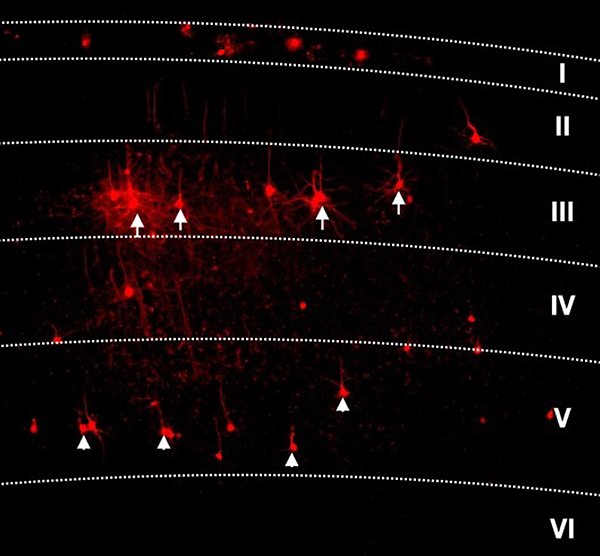Martinotti cells in cortical circuits for motor learning
Martinotti cells are small multipolar neurons with short branching dendrites. They are scattered mainly in cortical layer III and V with axonal arborization in cortical layer I and make contacts with the distal tuft dendrites of pyramidal cells in multiple columns. Recent research suggests that Martinotti cells are associated with a cortical dampening mechanism. Upon overexcitation of pyramidal neurons, Martinotti cells start sending inhibitory signals to the surrounding neurons.
We recently discovered that layer 5 Martinotti cells synchronize type A pyramidal cells in a frequency-dependent manner. Our findings suggest that layer 5 Martinotti cells are pivotal for coordinated PC activity, which is involved in cortical information processing and cognitive control (Hilscher et al., 2017, PLoS Biol., 15:e2001392). Thus, we hypothesize that they are involved in microcolumnar synchronization, possibly by inhibitory and/or disinhibitory mechanisms.
Inhibitory interneurons
Principal cells in layer 5 are the major source of output from the cortex to subcortical structures involved in behaviour. Inhibitory interneurons are thought to play a key role in shaping the activity and plasticity of principal cells through lateral inhibition, and interference of microcolumnar processing has been linked to a variety of neurological and psychiatric conditions including autism spectrum disorder, Alzheimer’s disease, drug addiction and schizophrenia.
The role of Martinotti cells in cortical processing
The function of Martinotti cells has been intensively studied using the marker somatostatin, which, although proven very useful, is promiscuous and labels multiple anatomical classes such as subsets of basket cells, bitufted, horizontal, and multipolar cells as well as long-projecting GABAergic neurons.
Our aim is to dissect and study the role of layer 5 Martinotti cells in cortical processing by genetic isolation using the Chrna2 promoter. Chrna2, which we have shown selectively labels layer 5 Martinotti cells in the cortex, also suggest a cholinergic influence on its functionalities. Our lab is now approaching the role of Martinotti inhibitory interneurons for microcolumnar processing connected to pyramidal neurons in the cortex and procedural memory formation.

Rabies virus tracing experiment where Martinotti cells (arrowheads) were infected and layer III pyramidal neurons were transsynaptically labeled (arrows).
